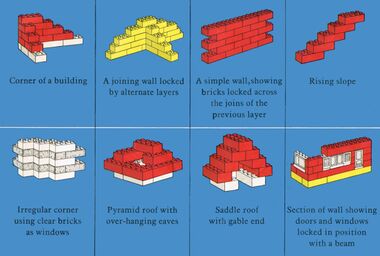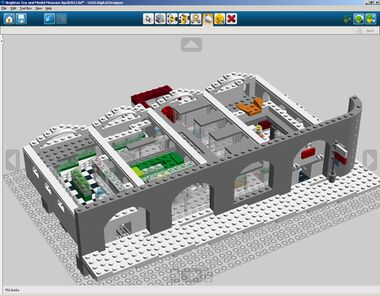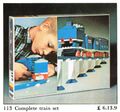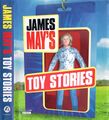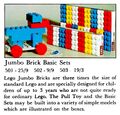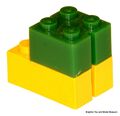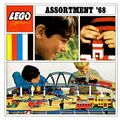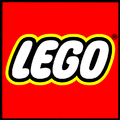Category:Lego System
| Toy Brands and Manufacturers |
|---|
Lego System |
| 1940s - |
Bricks: Original
|| Transitional
|| Modern || Duplo || Technic
Town Plan || Architecture || Legoland || City || Modular
Homemaker || Modular
Cars
|| Roofs
|| Windows and Doors
|| Wheels
4.5V Trains || 9V Trains
Maxifigures
|| Legoland figures
|| Minifigures
|| Microfigures
~1960: Lego System [image info]
~1960: Lego building instructions [image info]
1968 Lego System logo [image info]
A Lego Halloween Spider dangling in the museum lobby, Halloween 2012 [image info]
Brighton Toy and Model Museum, in Lego [image info]
Lego is a classic "plastic building blocks" toy that appeared in Denmark in around 1948 and became the world's favourite toy. The original Lego brick was based on an original design by English child development psychologist and inventor Hilary Page, and subsequently improved, to become the "modern" Lego brick in 1958.
Plurals
In the UK, "Lego" (when referring to the "bricks") refers to the Lego system or to a quantity of Lego pieces, and British users tend to react with horror to the US convention of referring to a Lego brick as "a Lego", or to the use of "Legos" as a plural. We don't know what the convention is in Denmark.
Characteristics
Standard Lego pieces typically have cylindrical raised pegs on their upper face and a hollow underside, and can be clipped together to make walls and more complex shapes. The proportions of Lego pieces are precisely defined in "metric" units, with ~4.8-millimetre-wide pegs arranged on an exact eight-millimetre grid, and with each brick's sides set back from the grid by an additional tenth of a millimetre to allow for clearance and flexing.
The side of a "standard" brick is precisely 9.6mm high, and for Lego "plates", the corresponding height is exactly 3.2mm (one third the height). These rigid official definitions have ensured that today’s LEGO bricks still fit those from 1958, despite any incidental changes in shape, colour and design that may have taken place over the years. As well as producing more "custom" pieces such as wheels, roof components, trees and the distinctive "Minifigures", Lego have produced a number of more specialised sets and several "themed" series ("Space", "Pirates", and so on). After producing a number of highly successful ranges designed to tie in with existing franchises, notably their "Star Wars" range, Lego went on to develop their own "in-house" theme brands (such as "Bionicle").
Lego Duplo
"Duplo" (1969-) is a "double-sized" version of Lego aimed at younger children, and has a "rabbit" mascot. Clever design allows a certain amount of interoperability between Lego and Duplo: a "2×2" Lego brick will usually clip onto a single stud on a Duplo brick, and a "4×2" Lego brick will usually clip to a pair of Duplo studs.
Lego Technic
Lego Technic (1977-) is designed more for the construction of mechanical models with complex moving parts, and includes more "engineering-based" pieces such as driveshafts and gears. Unlike normal Lego, "Technic" beams tend to be 8 mm on all sides with additional holes instead of studs, giving "Technic" models a "holey" appearance more similar to the FischerTechnik (1964-) and short-lived Philiform (1969-1972) plastic construction sets (and, to a lesser extent, to Meccano). Lego Technic parts, combined with a "programmable brick" developed by MIT Media Laboratory in the 1990s and various motors and sensors formed the basis of the Lego "Mindstorms" kits, for building simple robotic systems.
Origins
In 1932, carpenter and cabinetmaker Ole Kirk Christiansen set up a wooden-toy manufacturing business in the village of Billund, Denmark, supposedly adopting the name LEGO in 1934 from the Danish "Leg godt", meaning "play well". While there are various theories as to where the name came from (including one about the US plastic toy manufacturer Elgo, who Lego settled up with because of the similarity of the name), it might not be a complete coincidence that "Lego" is almost an anagram of "Ole C".
The company bought Denmark's first plastic injection-moulding machine in 1947 and by 1949 was producing about 200 different wooden and plastic toys, including "Automatic Binding Bricks", the predecessor of the modern Lego brick.
1962: USA
LEGO was introduced in the United States in 1962, initially via a deal with the US plastic suitcase manufacturer Samsonite.
Lego appeared in the US when the Vietnam War (1955-1975) was escalating and becoming increasingly unpopular with the US population (especially because the military draft meant that some US soldiers had been forced to join up), and some of Lego's 1960s advertising tapped into parents' anxiety over this: while some hobby magazines were full of adverts for guns and military academies, which caused some parents understandable anxiety over the idea that their children might be scooped up by military recruitment and sent overseas to become a casualty in a dangerous war that was increasingly being seen as unjust and immoral, Lego's advertising emphasised the idea that Lego would instead encourage children to be creative free-thinkers that might instead grow up to be designers, artists or architects.
Lego's rejection of militaristic themes is supposed to have gone so far that it supposedly refused to produce Lego in "drab green" and restricted the availability of Lego in green and brown (with the exception of trees and green "grass" baseplates), to make it more difficult to produce Lego models of army vehicles. Instead, LEGO promised that its products would "develop the child's critical judgement, manual dexterity, and ability to think for himself".
This conscious avoidance of anything to do with the military lasted until Lego won the Star Wars franchise, in which many of the vehicles had unavoidably obvious weaponry. The amount of money generated by the Lego "Star Wars" sets arguably saved the company, but at the cost of incurring quite strong disapproval from some parents, and the complaint that Lego was abandoning its pacifist ideals. Lego's rationalisation would presumably have been that Star Wars was pure fantasy, and that its implicit violence was as unlikely to cause copycat violence as the presence of cutlasses and cannons on a Lego "pirate ship" set. Although the Star Wars "blasters" looked similar to normal handguns, one could not easily obtain a lightsaber or an ion-cannon-equipped spaceship on an American high street – it was similarly difficult to join the Rebel Alliance and attack the Death Star. However, although Lego produced lots of police cars, fire engines and emergency rescue set vehicles they apparently never produced any contemporary army or war sets. The possible exception to this being a Lego "Toy Story" set that represented the movie's bright green plastic army figures – however, in the film, these weren't real army people, they were characters who thought that they were real army, but were actually mass-produced toys (which all gets slightly "meta").
1968 promotional text:
Children love to learn, to experiment, to find out. That is what children are really doing when they play. Play is learning made enjoyable.
A good toy is one which gives free reign to a child's natural creativity and does what he wants it to do. The best toy is one which goes on doing this year in, year out.
Lego is like that. The bricks fit together so easily and accurately that a very young child can use them, yet they are so versatile there is always something new, more complex, more exciting to build so that Lego grows with the child. It is never dauntingly difficult, never so simple that it is quickly outgrown and cast aside.
If the bricks become soiled with constant use, a quick swish in warm not hot) soapy or detergent water will bring them up bright and colourful again ready for more hours, days, years of absorbing, creative play.
At the age of 3 a child is entering the Lego age. He will be happy with a few bricks, but not too few or there will not be enough play possibilities to meet his needs. As a child grows older he needs more bricks to match his growing imagination. The more he has the more frequently he will play.
A Basic Set is the best start for a Lego collection because the Basic Sets have a balanced selection of the different Lego bricks and it is easy to build up the collection with the wide variety of little Supplementary boxes at pocket money prices. For birthdays or other special occasions another Basic Set is always most welcome or perhaps a Planpack. Planpacks contain the right number of bricks for building a special model such as a bus or a garage and the bricks can later be added to the collection.
By about 5 years old a child will be ready for the Lego motor with all the exiting new opportunities this gives for power driven models including complete Lego train layouts.
Every time you give children Lego the world of possibilities grows, for more Lego means better models and more fun.
— , Lego Group, , Lego System Assortment '68 UK catalogue, , 1968
Lego in the Museum
Starting at the very end of June 2019, the museum is hosting a special display of early "Lego company" products in its temporary display space, Area 25.
The special display, "Lego before Lego: A secret history", consists of pieces drawn from The Hatley Lego Collection, and includes early examples of Lego sets, as well as some of the wooden toys produced by the company up until 1960.
Fittingly, the display space is flanked by two displays of other "building" sets whose brands have not survived, including Airfix's "Betta Bilda". Meccano's "Cliki, and the Hilary Page Kiddicraft plastic bricks that were the inspiration for the Danish bricks.
Lego itself is still going strong, and in 2011, the company's North American sales exceeded one billion US dollars.
Brighton's Lego shop
To get to the Brighton Lego Store, walk directly away from the front of Brighton Station down Queens Road until you get to the Clock Tower. The Churchill Square Shopping Centre will be the large modern complex over to your right. The Lego Store used to be set into the building's front, but has now been moved inside, facing the lower atrium, and near to the lifts and escalators.
External links
- "50th Birthday of the Lego Brick" (lego.com)
- Lego History timeline, 1940-49 (aboutus.lego.com)
- "Brickipedia", a large wiki-based internet resource for Lego users (lego.wikia.com)
- LUGNET - International LEGO Users Group Network (www.lugnet.com)
- Legoland Windsor (legoland.co.uk)
- Bright Bricks, custom Lego design (bright-bricks.com)
Local "Lego" groups and organisations
- Lego Store, Brighton BN1 2TA
- The Southern Lego Train Club (SLTC) UK, homepage
- Legoland Windsor, UK
- The Brickish Association (www.brickish.org) - UK AFOL ("Adult Fans of Lego") group
Subcategories
This category has the following 27 subcategories, out of 27 total.
*
A
- Automatic Binding Bricks - Lego Mursten (Lego) (1 P, 5 F)
D
- Duplo (4 F)
E
- Early Lego sets (5 P, 12 F)
H
L
- Lego 4.5v - 12V Train System (17 F)
- Lego accessory packs (10 P, 35 F)
- Lego Architecture (11 F)
- Lego Creator (2 F)
- Lego Digital Designer (LDD) (1 P, 6 F)
- Lego Homemaker (9 P, 16 F)
- Lego Maxifigures (5 P, 11 F)
- Lego Microfigures (1 P, 2 F)
- Lego System by Samsonite (6 F)
- Lego Technic (1 P, 6 F)
- Lego wheels (3 P, 5 F)
- Lego windows and doors (1 P, 4 F)
- Legoland (theme park) (empty)
- Legoland figures (2 P, 3 F)
M
- Modern Lego Bricks (Lego) (empty)
R
- Lego roof bricks (1 P, 7 F)
Pages in category ‘Lego System’
The following 45 pages are in this category, out of 45 total.
B
F
L
N
Media in category ‘Lego System’
The following 190 files are in this category, out of 190 total.
- Aeroplane and Pilot, retail box (Lego 250).jpg 2,000 × 1,221; 220 KB
- Aeroplane, retail box (Lego 609).jpg 2,000 × 1,450; 255 KB
- American Embassy, Copenhagen, Lego model (LegoIB1 ~1962).jpg 2,654 × 2,388; 1.29 MB
- Angle and Valley Corner Tiles, Lego Set 283 (LegoCat ~1960).jpg 689 × 952; 67 KB
- Balcombe Viaduct (Ouse Valley Viaduct), Lego Digital Designer.jpg 995 × 560; 99 KB
- Base Plates, Lego Set 227 (LegoCat ~1960).jpg 689 × 952; 96 KB
- Base Plates, Lego Set 228 (LegoCat ~1960).jpg 689 × 952; 87 KB
- Base Plates, Lego Set 229 (LegoCat ~1960).jpg 689 × 952; 94 KB
- Battery Case, Lego 101 (LegoAss 1968).jpg 1,498 × 669; 166 KB
- Bevelled Bricks, Lego Set 280 (LegoCat ~1960).jpg 689 × 952; 56 KB
- Bevelled Bricks, Lego Set 281 (LegoCat ~1960).jpg 689 × 952; 70 KB
- Bevelled Bricks, Lego Set 282 (LegoCat ~1960).jpg 689 × 952; 65 KB
- Billinton E2 0-6-0 tank locomotive, Lego Digital Designer.jpg 598 × 449; 67 KB
- Breakdown Lorry, Lego 256 (LegoCat ~1960).jpg 689 × 476; 48 KB
- Brighton Toy and Model Museum (Lego model).jpg 1,024 × 512; 67 KB
- Brighton Toy and Model Museum rendered in Lego (LDD).jpg 1,280 × 998; 289 KB
- Build a Real Railway, Lego (LPWLego 1971).jpg 2,446 × 2,600; 1.77 MB
- Building Instructions, Lego (LegoCat ~1960).jpg 2,500 × 1,683; 324 KB
- Chain Pier, Brighton, Lego Digital Designer.jpg 819 × 459; 92 KB
- Church Special Box, Lego Set 309 (LegoCat ~1960).jpg 689 × 952; 75 KB
- Church, Lego model (LegoIB1 ~1962).jpg 1,945 × 2,379; 837 KB
- Complete Train Set, Lego 113 (LegoAss 1968).jpg 1,511 × 1,414; 361 KB
- Corner Bricks, Lego Set 217 (LegoCat ~1960).jpg 689 × 952; 67 KB
- Curved Bricks, Lego Set 224 (LegoCat ~1960).jpg 689 × 952; 59 KB
- Cyclists and Motorcyclists, Lego Set 270 (LegoCat ~1960).jpg 689 × 476; 62 KB
- De Bijenkorf, Holland (LegoIB1 ~1962).jpg 2,310 × 2,355; 951 KB
- Did you like. Lego Saturn V (Lego 92176).jpg 1,592 × 2,000; 555 KB
- Dolls Furniture for Girls (LPWLego 1971).jpg 1,392 × 3,000; 1.05 MB
- Dolls Furniture for Girls 260 261 (LegoCollGuide 1971).jpg 2,600 × 2,062; 1.19 MB
- Double Garage Special Box, Lego Set 306 (LegoCat ~1960).jpg 689 × 952; 84 KB
- E-Type Jaguar in Garage, Lego 670 (Lego ~1964).jpg 702 × 488; 68 KB
- Eight-Stud Bricks, Lego Set 218 (LegoCat ~1960).jpg 689 × 952; 67 KB
- Electronic control (LegoAss 1968).jpg 1,600 × 1,202; 343 KB
- Empire State Building, Lego model (LegoIB1 ~1962).jpg 2,423 × 3,000; 1.66 MB
- ESSO Lorry, Lego 251 (LegoCat ~1960).jpg 689 × 476; 44 KB
- Esso Petrol Pumps and Sign, Lego Set 231 (Lego ~1964).jpg 702 × 488; 53 KB
- ESSO Petrol Pumps, Lego Set 231 (LegoCat ~1960).jpg 689 × 476; 59 KB
- ESSO Tanker, Lego 250 (LegoCat ~1960).jpg 689 × 476; 51 KB
- ESSO Trailer, Lego 252 (LegoCat ~1960).jpg 689 × 476; 36 KB
- Family, retail box (Lego 254).jpg 2,000 × 1,170; 224 KB
- Fifty Lettered Bricks, Lego Set 234 (LegoCat ~1960).jpg 689 × 952; 65 KB
- Fifty Numbered Bricks, Lego Set 237 (LegoCat ~1960).jpg 689 × 952; 67 KB
- Fire Engine with Ladder, Lego 255 (LegoCat ~1960).jpg 689 × 476; 61 KB
- Fire Station Special Box, Lego Set 308 (LegoCat ~1960).jpg 689 × 952; 86 KB
- Flags Trees and Road Signs (Lego 939).jpg 2,000 × 1,279; 215 KB
- Ford Taunus in Garage, Lego 263 (Lego ~1964).jpg 702 × 488; 64 KB
- Four-Stud Bricks, Lego Set 220 (LegoCat ~1960).jpg 689 × 952; 59 KB
- Full Speed Ahead with Lego 4-5V Train (LPWLego 1971).jpg 2,600 × 1,839; 1.81 MB
- Garage Base with Automatic Door, Lego Set 235 (LegoCat ~1960).jpg 689 × 952; 86 KB
- Garage with Automatic Door, Lego Set 236 (LegoCat ~1960).jpg 689 × 952; 77 KB
- House with Garage, Lego PlanPack 324 (LegoAss 1968).jpg 1,534 × 708; 188 KB
- I360 (Lego Digital Designer).jpg 786 × 772; 54 KB
- Ideas Book (LegoAss 1968).jpg 1,543 × 702; 148 KB
- Illuminating Brick, Lego Set 245 (LegoCat ~1960).jpg 689 × 952; 67 KB
- International Flags, Lego Set 242 (LegoCat ~1960).jpg 689 × 952; 55 KB
- James Mays Toy Stories, cover and spine (ISBN 9781844861071).jpg 1,451 × 1,600; 1.39 MB
- Jeep, Lego PlanPack 330 (LegoAss 1968).jpg 1,543 × 776; 187 KB
- Jumbo Bricks, Basic Sets, Lego 501 502 503 (LegoAss 1968).jpg 1,534 × 1,467; 363 KB
- Karmann Ghia in Garage, Lego 265 (Lego ~1964).jpg 702 × 488; 62 KB
- Kiddicraft and Lego bricks.jpg 675 × 500; 49 KB
- Kiddicraft brick (green) and Lego Mursten brick (yellow).jpg 1,600 × 1,548; 147 KB
- Kindergarden, Lego model (LegoIB1 ~1962).jpg 2,000 × 1,669; 655 KB
- Kitchen set, box sleeve (Lego 263).jpg 2,200 × 1,473; 1.07 MB
- Kitchen set, interior box (Lego 263).jpg 2,200 × 1,468; 525 KB
- La Prevoyance Social, Belgium, Lego model (LegoIB1 ~1962).jpg 1,879 × 2,350; 714 KB
- Large Base Plate, Lego 700 E (LegoCat ~1960).jpg 1,378 × 952; 134 KB
- Large Wheels, Lego Set 401 (Lego ~1964).jpg 702 × 976; 87 KB
- Large-Size Lego Blocks, Samsonite (Schwarz 1967).jpg 2,739 × 1,247; 459 KB
- Lego 2x2 Brick.jpg 1,602 × 1,601; 143 KB
- Lego 2x4 Brick, top view.jpg 1,600 × 800; 88 KB
- Lego Accessories pack sleeve, Architect (Lego 1958).jpg 2,029 × 2,015; 648 KB
- Lego Accessories Pack Sleeve, bricks (Lego, 1958).jpg 2,036 × 2,019; 536 KB
- Lego and Lego Technic, brick profiles, evolution.jpg 1,062 × 629; 125 KB
- Lego Assortment 68, catalogue cover (Lego 1968).jpg 1,595 × 1,600; 518 KB
- Lego Basic Sets (LegoCat ~1960).jpg 1,600 × 1,069; 221 KB
- Lego Bioncle, jointed skeleton (Patent US D696361 2011).jpg 2,000 × 1,541; 259 KB
- Lego Bionicle (Patent US 2013324002 2011).jpg 2,000 × 1,153; 244 KB
- Lego Building Instructions (Lego ~1964).jpg 2,000 × 1,349; 296 KB
- Lego by Land, Trains (LegoIB1 ~1962).jpg 2,600 × 1,722; 1.27 MB
- Lego by Land, trains (LIB2 1962).jpg 2,600 × 1,688; 1.52 MB
- Lego Complete Town Plan Set, Lego 810 (Lego 1968).jpg 1,480 × 1,375; 423 KB
- Lego Creator 4939 Sports Car.jpg 1,024 × 768; 300 KB
- Lego Creator logo.jpg 923 × 203; 31 KB
- Lego Duplo (LegoCollGuide 1971).jpg 3,000 × 1,298; 949 KB
- Lego Duplo (Patent DE 1678326 1968).jpg 1,971 × 1,424; 237 KB
- Lego Duplo 510 512 513 (LPWLego 1971).jpg 3,000 × 1,381; 756 KB
- Lego Duplo interoperability (LPWLego 1971).jpg 1,000 × 1,000; 90 KB
- Lego flexible coupler (Patent CA 702336 A 1965.jpg 2,000 × 1,578; 206 KB
- Lego Halloween Spider (2012).jpg 1,024 × 768; 495 KB
- Lego Homemaker figure, head (1974).jpg 700 × 800; 60 KB
- Lego Homemaker figure, head (Patent US 3982353 1975).jpg 2,000 × 1,252; 156 KB
- Lego Homemaker figure, parts (Patent US 4028844 1975).jpg 2,000 × 1,660; 183 KB
- Lego Homemaker Figures (1974).jpg 2,200 × 2,196; 324 KB
- Lego Homemaker Kitchen, built.jpg 2,200 × 1,239; 263 KB
- Lego Kitchen 263, cover (LegoManual 263).jpg 2,000 × 1,992; 819 KB
- Lego Kitchen 263, figure 5 (LegoManual 263).jpg 2,000 × 1,737; 527 KB
- Lego Kitchen 263, full diagram (LegoManual 263).jpg 3,006 × 2,545; 1.64 MB
- Lego Kitchen 263, Homemaker figures (LegoManual 263).jpg 1,540 × 2,000; 350 KB
- Lego Mechanical Sets, Samsonite (Schwarz 1967).jpg 2,000 × 1,495; 481 KB
- Lego Microfigure (Patent US D611108 2008).jpg 1,322 × 2,000; 246 KB
- Lego Minifigure (Patent US 4205482 1977).jpg 1,847 × 2,000; 356 KB
- Lego Mursten aeroplane, end-slots (Lego ~1953).jpg 1,862 × 1,426; 1.36 MB
- Lego Mursten logo (~1953).jpg 2,000 × 751; 452 KB
- Lego Mursten Set (Lego ~1953).jpg 2,000 × 1,435; 521 KB
- Lego Mursten slotted brick, underside, branded (Lego ~1953).jpg 1,600 × 1,047; 265 KB
- Lego roof bricks (Lego, 1960s).jpg 2,500 × 2,500; 289 KB
- Lego Roof Bricks, lineart (Patent 3034254, 1959-1962).jpg 1,159 × 881; 215 KB
- Lego Second Generation bricks (Lego).jpg 1,515 × 1,600; 194 KB
- Lego Sets (Lego ~1964).jpg 1,600 × 1,089; 230 KB
- Lego Store, Brighton BN1 2TF.jpg 2,200 × 1,239; 1.42 MB
- Lego System (LegoCat ~1960).jpg 2,099 × 1,882; 586 KB
- Lego System by Samsonite, logo (1960s).jpg 793 × 521; 90 KB
- Lego System logo (1968).jpg 1,507 × 772; 88 KB
- Lego System range, Samsonite (Schwarz 1962).jpg 2,200 × 1,458; 549 KB
- Lego System single-sheet catalogue (LegoCat ~1960).jpg 2,500 × 1,264; 618 KB
- Lego System single-sheet catalogue (LegoCat ~1964).jpg 1,600 × 813; 329 KB
- Lego Technic beams.jpg 1,024 × 575; 310 KB
- Lego Technic helicopter 42020.jpg 1,024 × 768; 378 KB
- Lego Technic Helicopters 42020.jpg 1,024 × 766; 95 KB
- Lego Technic Logo.jpg 2,330 × 410; 81 KB
- Lego Technic pegs.jpg 1,024 × 767; 481 KB
- Lego Town Plan Board, Lego 200 (LegoCat ~1960).jpg 699 × 1,162; 132 KB
- Lego Town Plan Set, Samsonite (Schwarz 1962).jpg 1,993 × 1,641; 302 KB
- Lego trademarked logo.png 713 × 715; 39 KB
- Lego Train Accessories 150-156 (LegoAss 1968).jpg 3,000 × 1,500; 449 KB
- Lego train tracks (Patent US 3464624 1966).jpg 2,000 × 1,736; 360 KB
- Lego wheel and axle design (Patent 3234683, s1962).jpg 508 × 795; 87 KB
- Lego wheels and axles (Lego, 1960s).jpg 3,000 × 2,294; 398 KB
- Lego windows and doors (Lego, 1960s).jpg 3,000 × 2,504; 464 KB
- Lego windows, lineart (Patent 3284946, 1964-1966).jpg 1,056 × 798; 144 KB
- Legoland Figures and Microwheels, box art (Lego 1975).jpg 3,000 × 812; 280 KB
- Legoland logo (1975).jpg 2,000 × 537; 61 KB
- Little House, Lego Set 211 (LegoCat ~1960).jpg 689 × 476; 54 KB
- Little House, Lego Set 212 (LegoCat ~1960).jpg 689 × 476; 51 KB
- Little House, Lego Set 213 (LegoCat ~1960).jpg 689 × 476; 50 KB
- Little Shop, Lego Set 210 (LegoCat ~1960).jpg 689 × 476; 51 KB
- Locomotive with Motor, Lego 112 (LegoAss 1968).jpg 1,496 × 673; 162 KB
- London Bus, Lego PlanPack 313 (LegoAss 1968).jpg 1,534 × 698; 164 KB
- Mercedes 190SL in Garage, Lego 266 (Lego ~1964).jpg 702 × 488; 64 KB
- Mercedes-Benz in Garage, Lego 264 (Lego ~1964).jpg 702 × 488; 68 KB
- Motor with Three Sets of Wheels, Lego 100 (LegoAss 1968).jpg 1,490 × 678; 177 KB
- Mr and Mrs Stud (LPWLego 1971).jpg 1,435 × 1,600; 452 KB
- NASA Astronaut Microfigure (Lego 90398pb008).jpg 1,200 × 1,146; 148 KB
- No Limit With Lego, Samsonite (Schwarz 1967).jpg 2,000 × 1,985; 650 KB
- Opel Rekord in Garage, Lego 262 (Lego ~1964).jpg 702 × 488; 64 KB
- Petrol Station Special Box, Lego Set 310 (LegoCat ~1960).jpg 689 × 952; 89 KB
- Plan Your Dream House in Lego, 01 (LegoIB1 ~1962).jpg 2,000 × 1,313; 718 KB
- Plan Your Dream House in Lego, 02 (LegoIB1 ~1962).jpg 2,000 × 1,317; 608 KB
- Police Officers and Motorcycle, retail box (Lego 256).jpg 2,000 × 1,298; 218 KB
- Police Patrol, retail pack (Lego 659).jpg 2,000 × 1,126; 263 KB
- Removal Van, Lego 257 (LegoCat ~1960).jpg 689 × 476; 48 KB
- Road Signs, Lego Set 232 (Lego ~1964).jpg 702 × 488; 46 KB
- Road Signs, Lego Set 232 (LegoCat ~1960).jpg 689 × 476; 54 KB
- SAS Building, Copenhagen, Lego model (LegoIB1 ~1962).jpg 2,481 × 2,366; 1.04 MB
- Saturn V Building Instructions (Lego 92176).jpg 1,589 × 2,000; 803 KB
- Seven Beams with Names, Lego Set 226 (LegoCat ~1960).jpg 689 × 952; 62 KB
- Shell Garage, Lego PlanPack 325 (LegoAss 1968).jpg 1,543 × 697; 195 KB
- Single-Stud Bricks, Lego Set 222 (LegoCat ~1960).jpg 689 × 952; 64 KB
- Single-Stud Bricks, Round, Lego Set 223 (LegoCat ~1960).jpg 689 × 952; 64 KB
- Six-Stud and Eight-Stud Beams, Lego Set 225 (LegoCat ~1960).jpg 689 × 952; 71 KB
- Six-Stud Bricks, Lego Set 219 (LegoCat ~1960).jpg 689 × 952; 67 KB
- Sixteen-Stud Beams, Lego Set 225 (LegoCat ~1960).jpg 689 × 952; 69 KB
- Small Train with Motor, Lego 115 (LegoAss 1968).jpg 1,486 × 1,404; 362 KB
- Small Train Without Motor, Lego 111 (LegoAss 1968).jpg 1,502 × 683; 183 KB
- Small Wheels, Lego Set 400 (Lego ~1964).jpg 702 × 976; 70 KB
- Street Lamps, Lego Set 233 (Lego ~1964).jpg 702 × 488; 37 KB
- Street Lamps, Lego Set 233 (LegoCat ~1960).jpg 689 × 476; 42 KB
- Sud Aviation Caravelle airliner set (Legoland 687).jpg 1,600 × 784; 195 KB
- Super Train Set, Lego 119 (LegoAss 1968).jpg 2,992 × 1,540; 903 KB
- Taxi Station, retail box (Lego 368).jpg 2,000 × 1,106; 223 KB
- Taxi, Lego PlanPack 315 (LegoAss 1968).jpg 1,543 × 695; 197 KB
- Tipper Lorry, retail box (Lego 662).jpg 2,000 × 1,126; 182 KB
- Tipper Truck, Lego 253 (LegoCat ~1960).jpg 689 × 476; 46 KB
- Tower Block building (LegoIB1 ~1962).jpg 2,427 × 3,000; 1.48 MB
- Trailer, Lego 254 (LegoCat ~1960).jpg 689 × 476; 36 KB
- Train, boxed (Lego 323-1, 1964).jpg 1,222 × 419; 135 KB
- Trees and Bushes, Lego Set 230 (LegoCat ~1960).jpg 689 × 476; 48 KB
- Turntables, Lego Set 402 (Lego ~1964).jpg 702 × 976; 69 KB
- Twenty-Stud Beams, Lego Set 216 (LegoCat ~1960).jpg 689 × 952; 72 KB
- Two-Stud Bricks, Lego Set 221 (LegoCat ~1960).jpg 689 × 952; 61 KB
- Vauxhall Victor Estate in Garage, Lego 671 (Lego ~1964).jpg 702 × 488; 64 KB
- Volk's Electric Railway car, Lego Digital Designer.jpg 768 × 405; 69 KB
- Volkswagen 1500 in Garage, Lego 267 (Lego ~1964).jpg 702 × 488; 65 KB
- Volkswagen Beetle in Garage, Lego 261 (Lego ~1964).jpg 702 × 488; 65 KB
- VW Car Showroom Special Box, Lego Set 307 (LegoCat ~1960).jpg 689 × 952; 89 KB
- VW Delivery Van, Lego 258 (LegoCat ~1960).jpg 689 × 476; 36 KB
- VW Saloon Car in Special Case, Lego Set 261 (LegoCat ~1960).jpg 689 × 476; 59 KB
- VW Saloon Car, Lego 260 (LegoCat ~1960).jpg 689 × 476; 43 KB
- Windows and Door, Lego Set 214 (LegoCat ~1960).jpg 1,435 × 1,421; 203 KB
- Women of NASA. box art (Lego 21312).jpg 750 × 554; 349 KB


